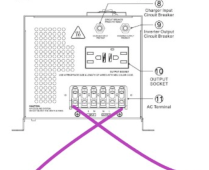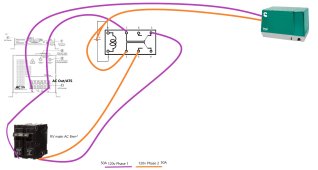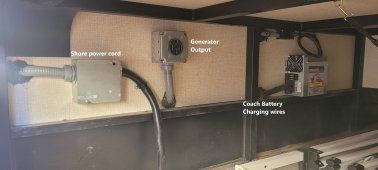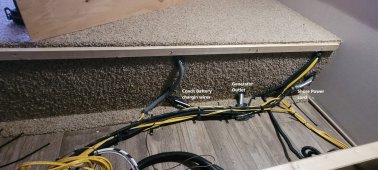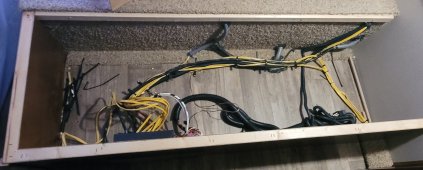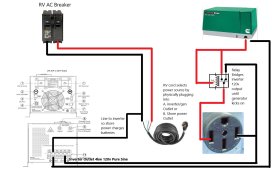CarlCruzin
New Member
I've put this project on the back burner for a while because I was a bit overwhelmed, but I'm trying to finally tackle it...
So I did my best to make a "wiring diagram" on paint with my components. This is just to draw out the idea and work out the kinks. Would those experienced and knowledgeable mind looking it over to make sure I'm not missing anything big? Or to offer alternatives?
A couple design considerations & compromises:
1. I purchased a single phase 120v output 4kw 48v Inverter/Charger/ATS and it only has a 40A bypass. Because of this, on both transfer switch options, one leg goes through the inverter/charger on the way to the breaker, and the second leg goes straight to the breaker.
1.1. Problem: When the generator is not running, only one of the legs will be powered. Is there a way to split the inverter output when the generator is not running, and not split when it is?
2. I intend to replace my coach batteries and eliminate the existing converter with this system, and my hydraulic levelers are on a 100A breaker, so I got a 100A DC-DC converter to power all things 12v
3. I intend to add solar later, but for now I will be charging via shore power
So I did my best to make a "wiring diagram" on paint with my components. This is just to draw out the idea and work out the kinks. Would those experienced and knowledgeable mind looking it over to make sure I'm not missing anything big? Or to offer alternatives?
A couple design considerations & compromises:
1. I purchased a single phase 120v output 4kw 48v Inverter/Charger/ATS and it only has a 40A bypass. Because of this, on both transfer switch options, one leg goes through the inverter/charger on the way to the breaker, and the second leg goes straight to the breaker.
1.1. Problem: When the generator is not running, only one of the legs will be powered. Is there a way to split the inverter output when the generator is not running, and not split when it is?
2. I intend to replace my coach batteries and eliminate the existing converter with this system, and my hydraulic levelers are on a 100A breaker, so I got a 100A DC-DC converter to power all things 12v
3. I intend to add solar later, but for now I will be charging via shore power
Attachments
Last edited:





